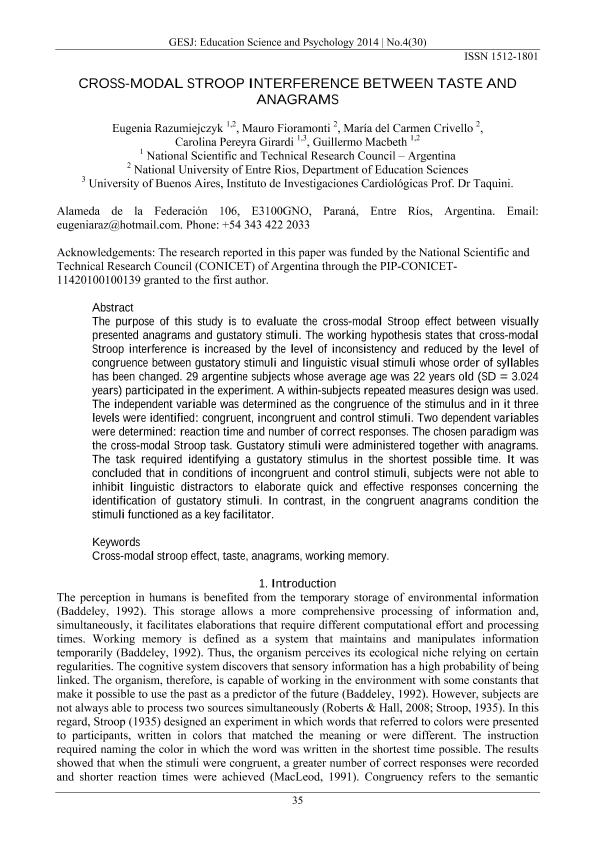Mostrar el registro sencillo del ítem
dc.contributor.author
Razumiejczyk, Eugenia

dc.contributor.author
Fioramonti, Mauro Bruno

dc.contributor.author
Crivello, María del Carmen

dc.contributor.author
Pereyra Girardi, Carolina Iris

dc.contributor.author
Macbeth, Guillermo Eduardo

dc.date.available
2016-10-24T17:18:11Z
dc.date.issued
2014-10
dc.identifier.citation
Razumiejczyk, Eugenia; Fioramonti, Mauro Bruno; Crivello, María del Carmen; Pereyra Girardi, Carolina Iris; Macbeth, Guillermo Eduardo; Cross-Modal stroop interference between taste and anagrams; Georgian Technical University; GESJ: Education Science and Psychology; 30; 4; 10-2014; 35-42
dc.identifier.issn
1512-1801
dc.identifier.uri
http://hdl.handle.net/11336/7780
dc.description.abstract
The purpose of this study is to evaluate the cross-modal Stroop effect between visually presented anagrams and gustatory stimuli. The working hypothesis states that cross-modal Stroop interference is increased by the level of inconsistency and reduced by the level of congruence between gustatory stimuli and linguistic visual stimuli whose order of syllables has been changed. 29 argentine subjects whose average age was 22 years old (SD = 3.024 years) participated in the experiment. A within-subjects repeated measures design was used. The independent variable was determined as the congruence of the stimulus and in it three levels were identified: congruent, incongruent and control stimuli. Two dependent variables were determined: reaction time and number of correct responses. The chosen paradigm was the cross-modal Stroop task. Gustatory stimuli were administered together with anagrams. The task required identifying a gustatory stimulus in the shortest possible time. It was concluded that in conditions of incongruent and control stimuli, subjects were not able to inhibit linguistic distractors to elaborate quick and effective responses concerning the identification of gustatory stimuli. In contrast, in the congruent anagrams condition the stimuli functioned as a key facilitator.
dc.format
application/pdf
dc.language.iso
eng
dc.publisher
Georgian Technical University
dc.rights
info:eu-repo/semantics/openAccess
dc.rights.uri
https://creativecommons.org/licenses/by-nc-sa/2.5/ar/
dc.subject
Cross-Modal Stroop Effect
dc.subject
Taste
dc.subject
Anagrams
dc.subject
Working Memory
dc.subject.classification
Psicología

dc.subject.classification
Psicología

dc.subject.classification
CIENCIAS SOCIALES

dc.title
Cross-Modal stroop interference between taste and anagrams
dc.type
info:eu-repo/semantics/article
dc.type
info:ar-repo/semantics/artículo
dc.type
info:eu-repo/semantics/publishedVersion
dc.date.updated
2016-08-30T17:11:04Z
dc.journal.volume
30
dc.journal.number
4
dc.journal.pagination
35-42
dc.journal.pais
Georgia

dc.journal.ciudad
Tbilisi
dc.description.fil
Fil: Razumiejczyk, Eugenia. Universidad Nacional de Entre Rios; Argentina. Consejo Nacional de Investigaciones Científicas y Técnicas; Argentina
dc.description.fil
Fil: Fioramonti, Mauro Bruno. Universidad Nacional de Entre Rios; Argentina
dc.description.fil
Fil: Crivello, María del Carmen. Universidad Nacional de Entre Rios; Argentina
dc.description.fil
Fil: Pereyra Girardi, Carolina Iris. Universidad Nacional de Entre Rios; Argentina. Consejo Nacional de Investigaciones Científicas y Técnicas. Oficina de Coordinación Administrativa Houssay. Instituto de Investigaciones Cardiológicas (i); Argentina
dc.description.fil
Fil: Macbeth, Guillermo Eduardo. Universidad Nacional de Entre Rios; Argentina. Consejo Nacional de Investigaciones Científicas y Técnicas; Argentina
dc.journal.title
GESJ: Education Science and Psychology
dc.relation.alternativeid
info:eu-repo/semantics/altIdentifier/url/http://gesj.internet-academy.org.ge/download.php?id=2330.pdf&t=1
Archivos asociados
